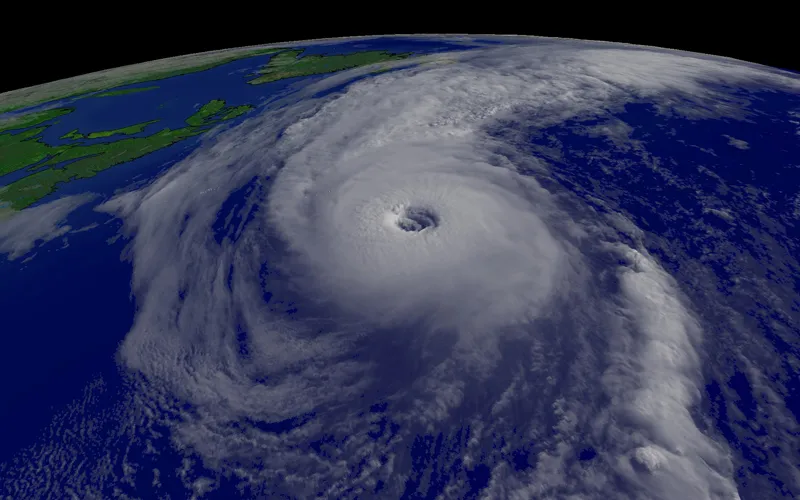Hurricanes

Hurricane Alex, a category 3 storm at its strongest, traveled north along the east coast of North America in August 2004 causing flooding, strong waves, and rip tides along the coast.
NOAA
As a strong hurricane heads towards the coast, people prepare -— boarding up houses, packing the car, and evacuating. These storms can spell disaster for people in hurricane-prone areas. Hurricanes are the most powerful of all weather systems. They are also huge — the average hurricane spreads across 340 miles (547 km).
How Hurricanes Form
Hurricanes form from disturbances in the atmosphere over warm, tropical ocean water. They die down when they move over land or out of the tropics and into cooler latitudes. These storms are called hurricanes in the Atlantic and typhoons or tropical cyclones in other areas of the world. Because of the Coriolis effect, the storms rotate counterclockwise in the Northern Hemisphere and clockwise in the Southern Hemisphere. At the center of the rotating storm is a small area of calm weather and clear skies called the eye of the storm. Surrounding the calm of the eye are the most intense winds of the storm and the thick clouds of the eyewall.
Hurricanes grow when a storm travels over areas of warm ocean water and there are low winds outside the storm and high levels of moisture in the atmosphere. With the Make a Hurricane simulation, you can figure out what areas of the Atlantic are most prone to hurricanes.
Not all storms are the same. Large and strong storms cause much more damage than small storms. In the Atlantic and Eastern Pacific, the Saffir-Simpson Hurricane Scale is used to describe hurricanes by their wind speed. Storms with winds less than 74 miles per hour are known as tropical storms. And if the wind speeds are less than 40 miles per hour, the storm is called a tropical depression.
Hurricane Damage
When a hurricane approaches land, strong waves and wind batter coastal towns. Hurricanes also cause a tremendous amount of rain to fall in a short amount of time, which can cause rivers to flood their banks and inundate areas that are both near the coast and further inland. But most coastal hurricane damage is typically flooding caused by storm surge and rainfall. Storm surge is the temporary rise in sea level that happens as the winds of the storm push water towards the coast. The low pressure of the storm and other factors also have an impact on storm surge. If storm surge happens at the same time as a high tide, the effect is more intense and more areas are flooded.
Hurricane Forecasting
As a hurricane moves across an ocean, scientists try to forecast where and when the storm will reach land. Their forecasts allow warnings to be issued in areas that the storm is likely to hit, giving people time to get out of the way. Watching hurricanes with weather satellites and using computer models to develop forecasts, scientists are able to predict the likely path of the storm. Hurricane models take into account what we know about the specific storm and what we know about the atmosphere and ocean. Since 1953 each hurricane has been given a name to help warn people that a new storm is on its way.
The time of year when hurricanes are likely to form is called hurricane season. This window of time is different in different regions of the world. In the North Atlantic, hurricane season is from June 1st to November 30th each year, however the season is predicted to extend by about a month before the end of the century due to climate change.
Hurricanes and Climate Change
We know a lot about how human-caused climate change is affecting hurricanes and tropical storms now, and how it will likely affect them in the future. Ocean warming due to climate change is causing hurricanes to become more intense, which means higher wind speeds. It also means larger amounts of precipitation and more risk of flooding. While the number of hurricanes each year isn't certain to increase, scientists predict that there will be more intense hurricanes (Category 4 or 5) as the climate continues to warm.
© 2024 UCAR with portions adapted from Windows to the Universe (© 2011 NESTA)